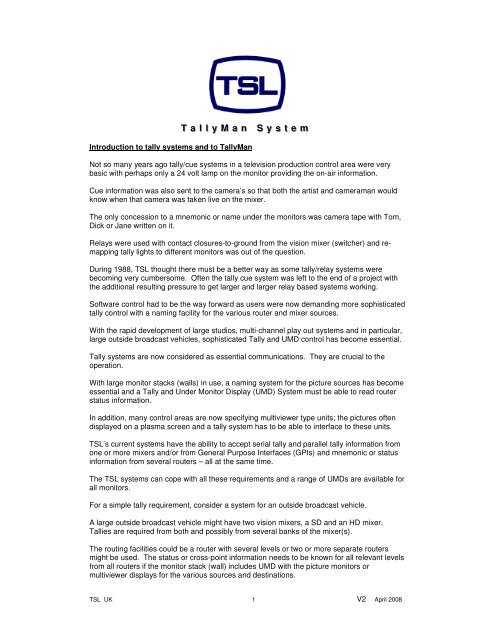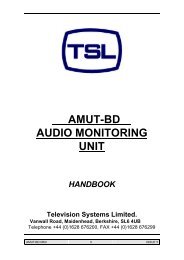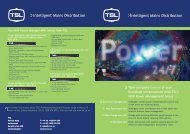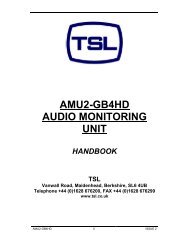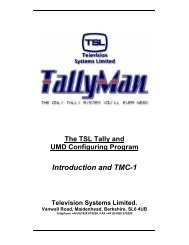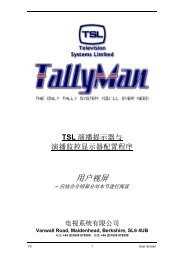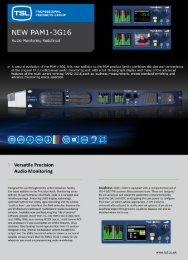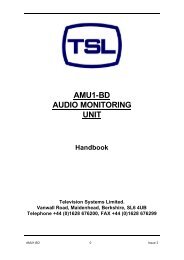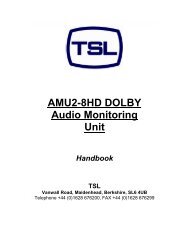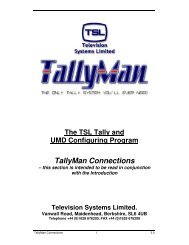You also want an ePaper? Increase the reach of your titles
YUMPU automatically turns print PDFs into web optimized ePapers that Google loves.
T aa l l yy M aa n S yy ss tt ee m<br />
Introduction to tally systems and to <strong>Tally</strong>Man<br />
Not so many years ago tally/cue systems in a television production control area were very<br />
basic with perhaps only a 24 volt lamp on the monitor providing the on-air information.<br />
Cue information was also sent to the camera’s so that both the artist and cameraman would<br />
know when that camera was taken live on the mixer.<br />
The only concession to a mnemonic or name under the monitors was camera tape with Tom,<br />
Dick or Jane written on it.<br />
Relays were used with contact closures-to-ground from the vision mixer (switcher) and remapping<br />
tally lights to different monitors was out of the question.<br />
During 1988, <strong>TSL</strong> thought there must be a better way as some tally/relay systems were<br />
becoming very cumbersome. Often the tally cue system was left to the end of a project with<br />
the additional resulting pressure to get larger and larger relay based systems working.<br />
Software control had to be the way forward as users were now demanding more sophisticated<br />
tally control with a naming facility for the various router and mixer sources.<br />
With the rapid development of large studios, multi-channel play out systems and in particular,<br />
large outside broadcast vehicles, sophisticated <strong>Tally</strong> and UMD control has become essential.<br />
<strong>Tally</strong> systems are now considered as essential communications. They are crucial to the<br />
operation.<br />
With large monitor stacks (walls) in use, a naming system for the picture sources has become<br />
essential and a <strong>Tally</strong> and Under Monitor Display (UMD) System must be able to read router<br />
status information.<br />
In addition, many control areas are now specifying multiviewer type units; the pictures often<br />
displayed on a plasma screen and a tally system has to be able to interface to these units.<br />
<strong>TSL</strong>’s current systems have the ability to accept serial tally and parallel tally information from<br />
one or more mixers and/or from General Purpose Interfaces (GPIs) and mnemonic or status<br />
information from several routers – all at the same time.<br />
The <strong>TSL</strong> systems can cope with all these requirements and a range of UMDs are available for<br />
all monitors.<br />
For a simple tally requirement, consider a system for an outside broadcast vehicle.<br />
A large outside broadcast vehicle might have two vision mixers, a SD and an HD mixer.<br />
Tallies are required from both and possibly from several banks of the mixer(s).<br />
The routing facilities could be a router with several levels or two or more separate routers<br />
might be used. The status or cross-point information needs to be known for all relevant levels<br />
from all routers if the monitor stack (wall) includes UMD with the picture monitors or<br />
multiviewer displays for the various sources and destinations.<br />
<strong>TSL</strong> UK 1 V2 April 2<strong>00</strong>8
The cameras need to be tallied - i.e. the red light needs to be lit - to indicate to both the<br />
cameraman and the artist that the camera is on-air. These days it is very common for two<br />
types of tally to be fed to the cameras.<br />
The camera may be taken to air on the mixer directly (from the CCU) or via a router feeding<br />
the mixer inputs and it might also be continuously recorded on a server or tape machine for<br />
alternative camera shots; behind the goal type of coverage.<br />
These two types of tally have become known as red and green (or Iso) tallies respectively.<br />
So, for example, if an Aux Bus on the SD mixer is providing the video feed to a VTR for isorecording,<br />
the cameraman needs to know that (no “nodding” on air when the director issues<br />
instructions to the cameraman over talkback!) so a green tally needs to be routed out of the<br />
tally system to the cameras. This will be in addition to the red tally derived from the Mixer<br />
PGM bus information.<br />
The VTR operator may also need to know that the Vision Operator has selected Camera 1 on<br />
an Aux Bus as his iso feed. He too, will have a UMD associated indicating VTR status and<br />
program feed.<br />
The monitor stack (wall) may have several monitors assigned to the router destinations. With<br />
the growing trend for more and more sources to be monitored, multiviewers feeding plasma<br />
displays are becoming common in trucks.<br />
Most multiviewers have the capability to show text and tallies so these may in effect be<br />
treated as separate monitors with their associated UMD.<br />
Single screens may incorporate their own tally lights but more likely they will have a UMD<br />
underneath or embedded into the picture area (IMDs) which will include tally lights. The tally<br />
lamps on this IMD/UMD should show when the camera is taken to air and also when the<br />
camera is being Iso-recorded.<br />
Very often tallies will need to be taken to other vehicles or output as GPIs on the tailboard of<br />
the vehicle.<br />
Relay outputs are the safest route to avoiding circulating ground current problems and by the<br />
same token, GPIs coming in from a source external to the truck and its electricity supply may<br />
be provided by using opto-isolated inputs.<br />
In large OB fleets, several vehicles may be used for major events and tally and router<br />
information in one truck may need to be seen in other trucks. A simple RS422 or CAT5 cable<br />
link is all that is required for this networked <strong>Tally</strong>Man facility.<br />
Taken all together, the tally system is likely to be quite complex and certainly very important.<br />
<strong>TSL</strong>, as a large system integrator with many hundreds of installations, has found that an 8<br />
character, tri-colour display with separately addressable tally lamps meets the majority of<br />
requirements. There are occasions where longer mnemonics or messages are required and<br />
16 character displays are available deal with this.<br />
<strong>Tally</strong>Man can deal with all these requirements and have the ability to be reconfigured merely<br />
by loading a prepared file that holds the new UMD mnemonics, tally mapping and initial router<br />
assignments for the particular show.<br />
<strong>TSL</strong> UK 2 V2 April 2<strong>00</strong>8
<strong>Tally</strong>Man<br />
To meet the need for an easily updated tally system, <strong>TSL</strong> developed <strong>Tally</strong>Man. This program<br />
builds on the experience gained from the original class-leading <strong>TSL</strong> Winsoft configuring<br />
program.<br />
The <strong>Tally</strong>Man program will have a familiar look to it as it mimics the familiar Windows<br />
directory and file view as seen in Explorer or My Computer.<br />
All system components may be changed at will and the program is virtually infinitely<br />
expandable up to the capacity of the computer hardware that is used as the platform.<br />
It is now becoming common for sophisticated gated tally mappings to be made, especially on<br />
OB trucks. In <strong>Tally</strong>Man, for example, it is possible to AND, OR (or any other logic function)<br />
tallies together.<br />
A major feature of <strong>Tally</strong>Man is the ability to have up to 16 channels of tallies. Tallies may<br />
therefore be assigned to any of the 16 tally channels available.<br />
Previous programs / systems (e.g. <strong>TSL</strong>’s Winsoft) have often provided two tally channels<br />
such as red and green.<br />
Note about twin tallying:<br />
In some circumstances, both a red and a green tally might have been linked to a router<br />
source via the tallied router buses – one bus has a red tally as it goes to air and another<br />
bus has a green tally assigned to it as it feeds a VTR for, say, behind-the-goal-action.<br />
Both router buses may select the same source and the red and green tallies, when<br />
mapped from the same red/green tallied router source to different output pins via a<br />
software filter or mask in the set-up program, allow the cameras to receive separate red<br />
and green tallies.<br />
In <strong>Tally</strong>Man, this tally channel idea is extended from 2 to 16 channels.<br />
In addition, <strong>Tally</strong>Man uses System Tallies. These are tallies that may be made from other<br />
tallies, possibly using logical operators such as AND, OR etc. to determine how the tally<br />
output from the System <strong>Tally</strong> behaves.<br />
A System <strong>Tally</strong> may be likened to a “multicore cable” or “wrapper” which can carry several<br />
tallies and tally channels. In this analogy, these tallies are the individual wires of the multicore<br />
cable,<br />
Several tallies may be assigned to a System <strong>Tally</strong> that “belong” to different <strong>Tally</strong> Channels<br />
An output mask must be selected that will determine which input tallies are allowed through to<br />
the System <strong>Tally</strong> output. This allows for rapid program by program changes.<br />
UMD Control<br />
Full colour control of the UMDs may be may from within the program and sophisticated colour<br />
control is possible via tally signals.<br />
<strong>TSL</strong> UK 3 V2 April 2<strong>00</strong>8
The following is intended to give a good overview of <strong>Tally</strong>Man – it does not replace the<br />
detailed information that is found in the manual.<br />
System interface Lists<br />
<strong>Tally</strong>Man can interface to all of the following: the list is not exhaustive.<br />
<strong>Tally</strong>Man Mixer/Switcher support as at April 2<strong>00</strong>8<br />
GVG Kalypso – Ross<br />
Thomson ACOS DD35<br />
Sony Serial <strong>Tally</strong><br />
Snell & Wilcox<br />
GVG M21<strong>00</strong><br />
Sony Extended Protocol<br />
Routers:<br />
<strong>Tally</strong>Man Router support as at April 2<strong>00</strong>8<br />
Protocol Control Alphanumeric<br />
BTS ASCII Yes No<br />
GVG Native Yes From Router<br />
BTS ESSwitch Yes From Router<br />
Kramer Yes No<br />
Leitch Yes No<br />
Network Yes No<br />
NVision Yes From Router<br />
Pesa Yes From Router<br />
Quartz Yes From Router<br />
SBUS (ROT16) Yes From Router<br />
Sigma Yes No<br />
Sony Yes No<br />
SWP02 Yes No<br />
SWP08 Yes From Router<br />
Talia No No<br />
VikinX Yes No<br />
<strong>Tally</strong>Man Displays support as at April 2<strong>00</strong>8<br />
<strong>TSL</strong> UMD (Most Multiviewers use this).<br />
Early Zandar DX Multiviewers<br />
Barco Vivaldi I<br />
Barco Vivaldi II<br />
Frens UMD<br />
Thomson BTS ASCII<br />
Barco Hydra<br />
When a new mainstream equipment is released the protocol / equipment type will be added to<br />
this list. This means that <strong>Tally</strong>Man upgrades will automatically offer greater connectivity.<br />
New <strong>Tally</strong>Man versions on the <strong>TSL</strong> web-site will often include new protocols.<br />
<strong>TSL</strong> UK 4 V2 April 2<strong>00</strong>8
Programming Facilities<br />
<strong>Tally</strong> Control<br />
• Sixteen tally channels or “tally families” allow easy and logical tally assignments to<br />
UMDs, router destination/sources and output pins for the cameras.<br />
• Provision for System Tallies consisting of internal “Boolean” tallies. These are<br />
defined combinations of other ordinary tallies (in or out)<br />
• Ability to use independent three colour control of the <strong>TSL</strong> UMDs<br />
• Ability to inhibit the left or right tally on any UMD.<br />
• Ability to map tallies to router sources.<br />
• Ability to map tallied router sources to a tally o/p pins for the cameras.<br />
• Ability to map tallies to router buses.<br />
• Ability to map tallied router buses to a tally o/p pins for cameras or other external tally<br />
lights etc.<br />
• Isolated relay-contacts for the parallel tally outputs by using ESP-1R .<br />
Mnemonic Control<br />
• All mnemonics can be of variable length.<br />
• Easy mnemonic control of the dynamic UMDs.<br />
• Drag and drop from mnemonic lists.<br />
• Ability to import mnemonics lists (e.g. from Excel) for router sources and destinations<br />
(buses).<br />
• Provides individual display control over tie-line recursion depth where routers are<br />
cascaded.<br />
• Control of individual UMD mnemonic and tally LED colour and mnemonic justification,<br />
either singly of as groups.<br />
• Ability to map cascaded routers so the o/p UMD shows the correct source mnemonic.<br />
• Router source to source and source to bus mapping possible.<br />
• Multiviewer support.<br />
• External router control from <strong>Tally</strong>Man.<br />
• Snapshot of router status may be taken and saved in a file<br />
• Downloading the names lists from some routers into <strong>Tally</strong>Man for display on the<br />
UMDs - where supported by the router manufacturer.<br />
• Uploading of UMD mnemonics from <strong>Tally</strong>Man into the router’s names lists – where<br />
supported by the router manufacturer.<br />
• Uploading of mnemonics from <strong>Tally</strong>Man into the switcher’s / mixer’s panel – where<br />
supported by the mixer manufacturer.<br />
General<br />
• Password control is offered allowing the configuring engineer to offer a fine level of<br />
control to less experienced users on a day to day basis.<br />
• <strong>Tally</strong>Man is configured by a standard PC running Windows 95, 98, NT4, 2<strong>00</strong>0 or XP,<br />
• Configuration of system components can be done “live” on the system.<br />
• Router sources and destinations may be sorted according to type (OS lines,<br />
Cameras, VTRs etc)<br />
• All current interfaces for various routers, mixers etc. are available and updateable via<br />
a flash update of the TMx unit<br />
• All system objects can be named for easy reference.<br />
• GUI on the computer monitor gives a representation of the actual monitor stack or<br />
wall.<br />
• There is the ability to save and open different configurations (<strong>Tally</strong>, Mnemonics and<br />
router mapping details). All parameters are saved in one file.<br />
• Names lists may be entered for tallies, routers and Controllers as “aide-memoirs”.<br />
<strong>TSL</strong> UK 5 V2 April 2<strong>00</strong>8
Getting Started<br />
Connecting together.<br />
Cameras<br />
Router<br />
UMD Wall<br />
<strong>Tally</strong>Man Controller<br />
TMx<br />
<strong>Tally</strong>Man<br />
PSU-22<br />
Ethernet<br />
Vision Mixer<br />
Serial Data paths<br />
Config PC running<br />
<strong>Tally</strong>Man<br />
<strong>TSL</strong> UK 6 V2 April 2<strong>00</strong>8
Important - Changing the IP address to match the system scheme if necessary.<br />
Connect a PC running HyperTerminal (for example) to the Mtce / Port 3 on the TM1.<br />
HyperTerminal Settings.<br />
Start HyperTerminal and then power up the TM1 and wait for about 10 secs. Press Y on the<br />
keyboard within 1 sec of the message appearing. Follow the on-screen instructions<br />
<strong>TSL</strong> UK 7 V2 April 2<strong>00</strong>8
• Pressing S or Enter on the PC’s keyboard will set the <strong>Tally</strong>Man units as the Main Unit<br />
For stand alone units this is what you want.<br />
• Pressing C will set it as a Controller so that it may be an Object in the system tree<br />
under a Main Controller for large systems.<br />
• Pressing B will set the unit as a Redundant Backup unit. See the section on Backup<br />
in the main manual for information on how to use this facility.<br />
• Pressing D will delete the current setup file; pressing any other key will allow access<br />
to the IP settings.<br />
• Pressing Y will revert the unit to factory software and will downgrade the unit to the<br />
previous version of the <strong>Tally</strong>Man Program provided that an upgrade has taken place<br />
in the field.<br />
• IP Addresses are set as shown. If no entry is made and the Enter key on the PC’s<br />
keyboard is pressed, the original settings will be kept.<br />
When all settings are correct remove the RS232 cable and re-power the unit.<br />
Notes.<br />
When using a TMx with a RS232 card fitted in the Control 3 position use the following cable:<br />
PC - TMx<br />
Pin 2 – Pin 3<br />
Pin 3 – Pin 2<br />
Pin 5 – Pin 5<br />
When using a TMx with a RS422 card fitted in the Control 3 position use the following cable:<br />
PC - TMx<br />
Pin 2 – Pin 2<br />
Pin 3 – Pin 8<br />
Pin 5 – Pin 4<br />
Next, place the CD in the tray and search for the <strong>Tally</strong>Man program directory. Double-click on<br />
<br />
to start the auto install.<br />
• A shortcut will be placed on the desktop for the tallyman.exe file.<br />
• Find the correct TMx set up file (Either for a TM1 or TM2) on the CD and copy it to<br />
the <strong>Tally</strong>Man directory on the configuring PC. This will automatically set the correct<br />
IP address in the program for the TMx box as set by the factory.<br />
• Run the program.<br />
• Open the correct TMx Set up file for the platform in use, found on the supplied CD<br />
ROM once the program is running.<br />
• Connect to the TMx as this file contains all the correct IP parameters.<br />
Go Off-line and you are now in a position to add objects such a mixers/switchers, routers and<br />
multiviewers.<br />
<strong>TSL</strong> UK 8 V2 April 2<strong>00</strong>8
Notes and tips.<br />
1. If you cannot connect with the PC to <strong>Tally</strong>Man, the PC may well be on a different IP<br />
group / subnet mask to <strong>Tally</strong>Man. Make sure that the PC has a fixed IP address set<br />
and that it is in the same group as the <strong>Tally</strong>Man unit.<br />
2. When making changes to any object, check that the serial port setting number has<br />
not changed as shown in the Communications dialog box.<br />
3. Use a RS422 LED data checker if you have no communication as evidenced by not<br />
tally indication in Tools > <strong>Tally</strong> Mimic or Tool > Router Mimic when On-Line. This will<br />
show immediately any wiring errors – the cause of most communications problems.<br />
4. Look for the rear RJ45 UMD data port LEDs winking, showing correct UMD activity.<br />
5. If a corrupt file is suspect it may be deleted via the HyperTerminal route.<br />
6. When programming it will be found very helpful to enter the Names of the various<br />
tallies, router sources etc at an early stage.<br />
7. Check the main manual for the UMD function descriptions: ie, Fixed Mnemonic,<br />
Follow Matrix Destination, etc.<br />
Initial Configuration.<br />
Once you have the correct initial file on the PC it is recommended that you add the Objects<br />
(Mixer, Router etc.) in the following order. This is not mandatory but may help with the<br />
configuration.<br />
1. Set the correct platform (TM1, TM2)<br />
2. Add the Mixer<br />
3. Add the Router<br />
4. Add any extra UMD drivers that may be needed.<br />
A few key requirements are now described.<br />
The method of adding components/objects is the same for all objects:<br />
Click on Add New Component on the main screen.<br />
<strong>TSL</strong> UK 9 V2 April 2<strong>00</strong>8
From the Add New System Component list select the Object to be added.<br />
When a new<br />
component is<br />
added to the<br />
system it must be<br />
given a Name<br />
before the OK<br />
button becomes<br />
active.<br />
This Name will be<br />
seen in the<br />
system tree on the<br />
left side of the<br />
screen.<br />
The protocol type<br />
is selected from<br />
the drop down box<br />
and here is shown<br />
as type GVG<br />
Kalypso. Press<br />
Apply.<br />
The Size will be<br />
set for some<br />
mixers/routers – if<br />
they are not set<br />
enter the<br />
appropriate<br />
number in the<br />
Size box.<br />
The Mixer/Router<br />
Sources and<br />
Destinations are<br />
seen in the LH<br />
column.<br />
When the protocol type has been selected, press Apply.<br />
Then set the Main Communication under Assign Interfaces.<br />
<strong>TSL</strong> UK 10 V2 April 2<strong>00</strong>8
The Port Number refers to the hardware port on the rear of the <strong>Tally</strong>Man unit. The<br />
Description text is optional.<br />
The Serial Parameters will be automatically filled for the manufacturer’s default settings.<br />
These may be changed, if necessary.<br />
Some mixers and router will be connected via an IP link. This method, where allowed, is<br />
shown on the Type drop-down box.<br />
For the Mixer:<br />
Mixer Program <strong>Tally</strong> to Mixer Source Mapping.<br />
A Program <strong>Tally</strong> module is usually provided for each mixer. These Program Tallies should be<br />
set to the Mixer Sources<br />
Mixer Program <strong>Tally</strong>.<br />
<strong>TSL</strong> UK 11 V2 April 2<strong>00</strong>8
Add the Program <strong>Tally</strong> to the source.<br />
This is the linking in <strong>Tally</strong>Man. The box below indicates the <strong>Tally</strong>Man object. The video path<br />
is indicated only to show that the tallies may be regarded as running in the opposite direction<br />
to the actual video.<br />
Video<br />
Mixer Module<br />
<strong>Tally</strong><br />
Map the appropriate Program<br />
<strong>Tally</strong> In to the appropriate Mixer<br />
Source in <strong>Tally</strong>Man<br />
<strong>TSL</strong> UK 12 V2 April 2<strong>00</strong>8
Adding Router modules<br />
Add a router in the usual way to the <strong>Tally</strong>Man tree.<br />
If the router destination(s) are linked to the Mixer inputs set this link in <strong>Tally</strong>Man from the<br />
Mixer Source screen.<br />
If the router is a monitoring router set the Mixer Source to the Router Source in Source to<br />
Source mapping from the Mixer Edit Source screen.<br />
Tip:<br />
Either the Name or the Mnemonic may be selected to show here from the View > Options<br />
menu item<br />
<strong>TSL</strong> UK 13 V2 April 2<strong>00</strong>8
In more detail:<br />
The router source may be mapped to:<br />
• A router source – source to source mapping<br />
• A router destination – source to destination mapping<br />
With source to source mapping, a Separate Mnemonic may be set which is the Mnemonic<br />
shown on this screen. All tally mapping will be dynamic but the mnemonic will stay as shown<br />
in the box with the green text at the top of this screen.<br />
Assign to Source<br />
When this option is selected in the Assignment box, a Display on the second router output<br />
will show the mnemonic and tally state of the assigned source. In this example, “CAM 1” will<br />
be shown, assuming that the Router 2 Bus has selected its input, SRCE 129.<br />
SRCE 193<br />
SRCE 129<br />
CAM 1<br />
Router 1<br />
Lines<br />
Router<br />
Router 2<br />
Main<br />
Router<br />
CAM 1<br />
<strong>Tally</strong>Man Link<br />
<strong>TSL</strong> UK 14 V2 April 2<strong>00</strong>8
The mnemonic for the input to Router 2, SRCE 129, is effectively taken over by the input<br />
mnemonics of Router 1. In this example, the mnemonic shown on the UMD will be those for<br />
SRCE 193. Tallies from either source will be shown.<br />
Therefore, in this example, only the mnemonics for Router 1 need be entered in the<br />
mnemonics lists.<br />
(Source to Source mapping may also be done within one router).<br />
An exception to this is when the Separate Mnemonic box is checked. Although the tallies<br />
will effectively be added together, the mnemonics will be kept separate.<br />
Multilevel Routers<br />
If a source is assigned to a destination, it is possible to specify a particular Level for the<br />
assignment.<br />
Leaving the Level set to Normal means that any UMD assignment will take its selected level<br />
and path through <strong>Tally</strong>Man.<br />
<strong>TSL</strong> UK 15 V2 April 2<strong>00</strong>8
Assignment to Destination<br />
The Category is<br />
shown as OS –<br />
Outside Source.<br />
This is used when there is more than one router in the system and displays need to show the<br />
correct original source mnemonic.<br />
CAM 1<br />
Router 1<br />
Lines<br />
Router<br />
DST 161<br />
<strong>Tally</strong>Man Link<br />
SRC 129<br />
Router 2<br />
Main<br />
Router<br />
CAM 1<br />
A display on the Main Router bus needs to show the correct Lines Router source mnemonic.<br />
In the example above, Router 2 is the final Router in the chain. Input 1 on Router 2 has the<br />
mnemonic “SRC 129”.<br />
This input 1 is connected to Router 1, Bus 1, which has the mnemonic “DST 161”. Router 1<br />
will also have mnemonics assigned to it’s sources.<br />
It is these source mnemonics that will be shown on the Router 2 Bus Display.<br />
Therefore, the linking will now ensure that the Router 2 Bus Display shows the correct Router<br />
1 source mnemonic which is selected by Router 1, Bus 1.<br />
<strong>TSL</strong> UK 16 V2 April 2<strong>00</strong>8
Tallies to UMDs<br />
If UMDs (or multiviewer displays) are assigned to either router destinations or sources they<br />
will display tallies via that path. This explains why it is important to get the mixer to router<br />
linking correctly carried out.<br />
Tallies may also be set directly to the UMD and may add or be Exclusive to any routerderived<br />
tallies.<br />
Set the <strong>Tally</strong> Channel mask to allow tallies through. A System <strong>Tally</strong> (see main manual) may<br />
contain tallies that belong to various channels. Be sure to select these channels in the mask<br />
if you want them displayed on the UMD.<br />
<strong>TSL</strong> UK 17 V2 April 2<strong>00</strong>8
<strong>Tally</strong> Outputs to Cameras<br />
The tally outputs to the camera CCUs are available on the D37 connectors. In the TMx units<br />
these are Open Collector circuits.<br />
Choose an output tally pin and map input tallies to it – usually a router source if there is a<br />
router in the system.<br />
It will be seen that any router switching or input-to-mixer changes will automatically allow the<br />
correct CCU tally signalling if this tally mapping method is followed.<br />
Note:<br />
Many camera CCUs will take Open Collector signalling. An exception is the current range of<br />
Thomson Cameras. Here, isolated relay closures are required so an additional relay unit from<br />
the <strong>Tally</strong>Man range is required, the ESP-1R.<br />
The full manual should be used as the reference document as <strong>Tally</strong>Man allows<br />
sophisticated tally control along with router switching and Names into mixer panels etc.<br />
<strong>TSL</strong> UK 18 V2 April 2<strong>00</strong>8


